Facts and data on pictograms

Synonyms
Baggage Reclaim, Luggage Claim, Baggage Belt
Category
Travel, Transport Facilities, Processing Activities, Tourism
Message / Function
To indicate the location of baggage reclaim point
| Source | Description | |
|---|---|---|
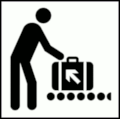 |
UIC 413 | Side view of human figure lifting suitcase from conveyor belt, arrow on baggage pointing towards human figure |
 4) 4) |
ÖNORM A 3011 | Side view of human figure lifting suitcase from conveyor belt, arrow on baggage pointing towards human figure |
 4) 4) |
ON Testdesign | Front view of human figure lifting suitcase from conveyor belt, arrow pointing towards baggage and human figure |
 4) 4) |
ON Testdesign | Front view of human figure lifting suitcase from conveyor belt, arrow pointing towards baggage and human figure |
 |
Icograda | Side view of human figure bending towards bag on conveyor belt as dotted arrow |
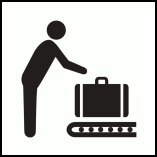 |
ISO 7001 | Side view of human figure bending towards suitcase on conveyor belt |
 |
EJP | Side view of human figure bending towards suitcase on conveyor belt |
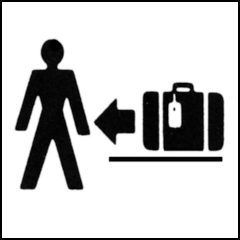 |
ATA | Human figure, suitcase on flat surface plus arrow pointing towards human figure |
 1) 1) |
S/TA | Human figure, suitcase plus arrow pointing towards human figure |
 |
ON Testdesign | Human figure, suitcase with arrow above, pointing towards human figure |
 2) 2) |
ON Testdesign | Partial view of suitcase and human figure, arm pointing towards suitcase |
 2) 2) |
ON Testdesign | Partial view of suitcase and human figure, arm pointing away from suitcase |
 |
ON Testdesign | Direction arrow pointing out of opening of rectangular enclosure away from suitcase |
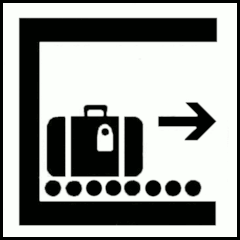 3) 3) |
ON Testdesign | Direction arrow pointing out of opening of rectangular enclosure away from suitcase on conveyor belt |
 3) 3) |
UIC 413 b | Suitcase on conveyor belt, upwards pointing arrow above |
 |
O'72 | Suitcase on roller conveyor |
 |
DB | Suitcase on roller conveyor |
 |
DB | Suitcase on roller conveyor |
 |
Novum 2/84 | Suitcase on roller conveyor |
 |
PANYNJ | Suitcase on roller conveyor |
 |
IATA | Hand holding tilted suitcase, conveyor belt below |
 |
CNIS | Hand holding tilted suitcase with label plus horizontal line below |
 |
BS 8501:2002 | Hand holding tilted suitcase with label plus horizontal line below |
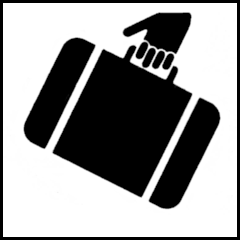 |
Icograda | Hand holding tilted suitcase |
 |
ON Testdesign | Direction arrow pointing away from suitcase |
 |
AIGA | Suitcase |
 |
Eco-Mo Foundation |
Suitcase |
 |
IATA | Side view of suitcase with label, box in front |
 |
TC | Side view of suitcase and bag, each with badges |
 |
Dreyfuss | Airplane pointing downwards, suitcase and horizontal line below |
Note: Some of the examples shown above were mirrored horizontally to contrast differences.
Discussion
In Appropriateness Ranking Tests conducted in the context of the Icograda student project (Frascara) and the ISO test series 1979/80 (Easterby & Graydon, 1981 a) more than 30 pictogram variants of the referent Baggage Claim were examined. Three out of the best six were tested for comprehension (Easterby & Graydon, 1981 b) and all elicited significant amounts of wrong responses. The Seattle-Tacoma Airport pictogram labeled 1) performed best with just 27.6 % correct responses. Testing was done without providing context information.
Based on these findings the working group 6 of the relevant Austrian Standards committee FNA 133 and a working group of the UIC developed several test designs which were examined in an Appropriateness Ranking Tests (Brugger, 1992 a). This test showed that the variants marked with 2) did not differentiate between Baggage Check-in and Baggage Claim and were judged as least appropriate of the pictograms studied. The pictogram labeled as UIC 413 b and marked with 3) reached the best comprehension scores in a follow up Comprehension Test (Brugger, 1992 b), closely followed by the test design also marked with 3). But 56 % and 50 % correct responses still were judged as insufficient. A look at wrong answers showed that pictograms showing also a conveyor belt or roller conveyor elicited less responses like left luggage, and large arrows in variants also were intepreted as directional information like Exit for travellers or Check-in in this direction.
Following these tests several additional variants were developed. In a Matching Test (Brugger, 1995 a) focusing on Baggage Check-in and Baggage Claim the pictograms marked with 4) (designed by Karl Scheiber) all were well understood and selected correctly by 80 % resp. 78 % of the respondents. The three other variants examined performed not as well: the suitcase on a roller conveyor labeled DB for example was correctly selected by 52 % only, and a variant showing just a suitcase by 33 %. These two pictograms often were confused with Left Luggage. In a follow up Comprehension Test (Brugger, 1995 b) the pictogram labeled as ÖNORM A 3011 in the table above reached 67 % correct responses, better than all results before.
The decision of AIGA to use the same pictogram for Baggage Check-in as well as for Baggage Claim may work in those environments, where a clear separation of passenger streams is guaranteed and no other baggage related facilities/activities could be searched for. Other applications or circumstances might lead into difficulties due to the ambiguity of the message conveyed. In a Japanese study the suitcase labeled as Eco-Mo Foundation suprisingly reached a comprehension score of 62.1 (Eco-Mo Foundation, 2001), a value never reached anywhere before when tested for Baggage Claim.
Recommendations
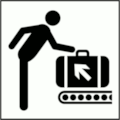

Based on the test results known, we recommend the use of pictograms like No 139 of the Austrian Standard ÖNORM A 3011 or the UIC version B.2.7 shown above to indicate the location of baggage reclaim point.
Tests of pictograms of referent Baggage Claim
Brugger, Ch. (1992 a): Reihungstest 1992. Report to the Austrian Standards Institute (ON) FNA 133 dated August 1992, Vienna.
Brugger, Ch. (1992 b): Verständnistest 1992. Report to the Austrian Standards Institute (ON) dated October 1992, Vienna.
Brugger, Ch. (1995 a): Matching-Test Gepäcksaufgabe / Gepäcksabholung - Bericht an ÖBB-GD 02. Vienna, June 1995.
Brugger, Ch. (1995 b): Verständnistest 1995 - Im Auftrag der ÖBB und des ON - FNA 133. Vienna, November 1995.
Brugger, Ch. (1999): Public information symbols: a comparison of ISO testing procedures. In: Zwaga, H., Boersema, T. & Hoonhout, H. (Eds.): Visual information for everyday use. London: Taylor & Francis Ltd.
Easterby, R.S. & Graydon, I.R. (1981 a): Evaluation of Public Information Symbols: ISO Test: 1979/80 Series. Part I: Appropriateness Ranking Tests. AP Report 99, Applied Psychology Department, University of Aston in Birmingham, January 1981.
Easterby, R.S. & Graydon, I.R. (1981 b): Evaluation of Public Information Symbols: ISO 1979/80 Test Series. Part II: Comprehension/Recognition Tests. AP Report 100, Applied Psychology Department, University of Aston in Birmingham, January 1981.
Eco-Mo Foundation (2001): Test data of public information symbols in Japan - Procedure for the testing of public information symbols by the Study Committee. ISO: ISO/TC 145/SC 1 N 329.
Magyar, S. (1993): Sorolási Teszt 1993. Készült az MSZH felkérésére. Budapest, January 1993.
See also
Updated 2023-03-20